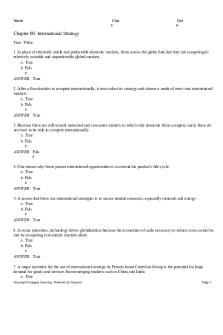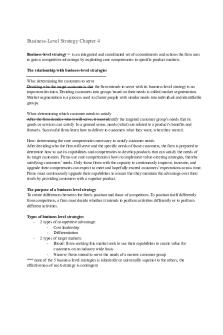Business-Level Strategy Chapter 4 PDF

| Title | Business-Level Strategy Chapter 4 |
|---|---|
| Course | Strategy and Competition |
| Institution | Concordia University |
| Pages | 6 |
| File Size | 258.8 KB |
| File Type | |
| Total Downloads | 555 |
| Total Views | 809 |
Summary
Business-Level Strategy Chapter 4Business-level strategy = is an integrated and coordinated set of commitments and actions the firm uses to gain a competitive advantage by exploiting core competencies in specific product markets.The relationship with business-level strategiesWho: determining the cus...
Description
Business-Level Strategy Chapter 4 Business-level strategy = is an integrated and coordinated set of commitments and actions the firm uses to gain a competitive advantage by exploiting core competencies in specific product markets. The relationship with business-level strategies Who: determining the customers to serve Deciding who the target customer is that the firm intends to serve with its business-level strategy is an important decision. Dividing customers into groups based on their needs is called market segmentation. Market segmentation is a process used to cluster people with similar needs into individual and identifiable groups. What: determining which customer needs to satisfy After the firm decides who it will serve, it must identify the targeted customer group’s needs that its goods or services can satisfy. In a general sense, needs (what) are related to a product’s benefits and features. Successful firms learn how to deliver to customers what they want, when they want it. How: determining the core competencies necessary to satisfy customer needs After deciding who the firm will serve and the specific needs of those customers, the firm is prepared to determine how to use its capabilities and competencies to develop products that can satisfy the needs of its target customers. Firms use core competencies (how) to implement value-creating strategies, thereby satisfying customers’ needs. Only those firms with the capacity to continuously improve, innovate, and upgrade their competencies can expect to meet and hopefully exceed customers’ expectations across time. Firms must continuously upgrade their capabilities to ensure that they maintain the advantage over their rivals by providing customers with a superior product. The purpose of a business level strategy To create differences between the firm's position and those of competitors. To position itself differently from competitors, a firm must decide whether it intends to perform activities differently or to perform different activities. Types of business level strategies - 2 types of competitive advantage: - Cost leadership - Differentiation - 2 types of target markets: - Broad: firms seeking this market seek to use their capabilities to create value for customers on an industry wide basis - Narrow: firms intend to serve the needs of a narrow customer group *** none of the 5 business level strategies is inherently or universally superior to the others, the effectiveness of each strategy is contingent
Cost leadership An integrated set of actions taken to produce goods or services with features that are acceptable to customers at the lowest cost, relative to that of competitors. - Commonly sell standardized goods/services, but with competitive levels of differentiation to the industry’s most typical customers - Similar products at a lower cost
Rivalry with existing competitors Having the low-cost position is valuable when dealing with rivals. Because of the cost leader’s advantageous position, rivals hesitate to compete on the basis of price, especially before evaluating the potential outcomes of such competition Bargaining power of buyers (customers) Powerful customers can force a cost leader to reduce its prices, but not below the level at which the cost leader’s next-most-efficient industry competitor can earn average returns. Although powerful customers might be able to force the cost leader to reduce prices even below this level, they probably would choose not to do so Bargaining power of suppliers The cost leader generally operates with margins greater than those of competitors and often tries to increase its margins by driving costs lower. Among other benefits, higher gross margins relative to those of competitors make it possible for the cost leader to absorb its suppliers’ price increases Potential entrants
Through continuous efforts to reduce costs to levels that are lower than competitors, a cost leader becomes highly efficient. Because increasing levels of efficiency (e.g., economies of scale) enhance profit margins, they serve as a significant entry barrier to potential competitors. New entrants must be willing to accept less than average returns until they gain the experience required to approach the cost leader’s efficiency Product substitutes Compared with its industry rivals, the cost leader also holds an attractive position relative to product substitutes. A product substitute becomes a concern for the cost leader when its features and characteristics, in terms of cost and differentiation, are potentially attractive to the firm’s customers How to drive down costs without sacrificing too much willing to pay? ● Economies of scale; ● Production mechanization and automation; Process standardization ● Product design to economize on materials; Waste reducing programs ● Efficient inbound & outbound logistics; ● Bargaining power over suppliers; ● Managerial and organizational efficiency; ● Outsourcing; etc. … Risks using a cost leadership strategy include: - the processes used by the cost leader to produce and distribute its good or service could become obsolete because of competitors’ innovations → loss of competitive advantage to newer technologies - too much focus by the cost leader on cost reductions may occur at the expense of trying to understand customers’ perceptions of “competitive levels of differentiation” → failure to detect changes in customer needs - Using their own core competencies, competitors sometimes learn how to successfully imitate the cost leader’s strategy → imitation Differentiation Strategy An integrated set of actions taken to produce goods or services (at an acceptable cost) that customers perceive as being different in ways that are important to them. - Price premium from unique product
Rivalry with existing competitors Customers tend to be loyal purchasers of products differentiated in ways that are meaningful to them. As their loyalty to a brand increases, customers’ sensitivity to price increases is reduced. The relationship between brand loyalty and price sensitivity insulates a firm from competitive rivalry. Thus, reputations can sustain the competitive advantage of firms following a differentiation strategy. Bargaining power of buyers The distinctiveness of differentiated goods or services reduces customers’ sensitivity to price increases. Customers are willing to accept a price increase when a product still satisfies their unique needs better than a competitor’s offering. Bargaining power of suppliers Because the firm using the differentiation strategy charges a premium price for its products, suppliers must provide high-quality components, driving up the firm’s costs. Potential entrants Customer loyalty and the need to overcome the uniqueness of a differentiated product create substantial barriers to potential entrants. Entering an industry under these conditions typically demands significant investments of resources and patience while seeking customers’ loyalty. Product substitutes Firms selling brand-name goods and services to loyal customers are positioned effectively against product substitutes.
How to raise the willingness to pay a great deal with only a slight increase in costs? ● Offer products/services with unique features for which customers are willing to pay price premium ● Seek to be different from competitors on as many dimensions as possible (superior design, responsive customer service, rapid product innovations, perceived prestige and status, different tastes, etc.) ● Increase customers’ reluctance to switch to non-unique products Risks of using differentiation strategy include: - customers might decide that the price differential between the differentiator’s product and the cost leader’s product is too large - a firm’s means of differentiation may cease to provide value for which customers are willing to pay → not worth the higher price - experience can narrow customers’ perceptions of the value of a product’s differentiated features - Counterfeiting or knock offs Focus strategies → cost leadership & differentiation focus strategy is an integrated set of actions taken to produce goods or services that serve the needs of a particular competitive segment. Examples of specific market segments that can be targeted by a focus strategy include: 1. a particular buyer group (youths or senior citizens), 2. a different segment of a product line (products for professional painters or the do-it-yourself group), 3. a different geographic market (e.g., northern or southern Italy by using a foreign subsidiary) Focused cost leadership strategy Although it is a cost leader, IKEA also offers some differentiated features that appeal to its target customers, including its unique furniture designs, in-store playrooms for children, wheelchairs for customer use, and extended hours. Thus, IKEA’s focused cost leadership strategy also includes some differentiated features with its low-cost products. Focused differentiation strategy With a focus strategy, firms must be able to complete various primary value-chain activities and support functions in a competitively superior manner to develop and sustain a competitive advantage and earn above-average returns. Risks of focus strategies include: - competitor may be able to focus on a more narrowly defined competitive segment and thereby “out-focus” the focuser - a company competing on an industry-wide basis may decide that the market segment served by the firm using focus strategy is attractive and worthy of competitive pursuit - the needs of customers within a narrow competitive segment may become more similar to those of industry-wide customers as a whole over time
Integrated cost leadership/differentiation strategy Involves engaging in primary value-chain activities and support functions that allow a firm to simultaneously pursue low cost and differentiation. Flexible manufacturing systems - Using a flexible manufacturing system (FMS), the firm integrates human, physical, and information resources to create relatively differentiated products at relatively low costs - The goal of a FMS is to eliminate the “low cost versus product variety” tradeoff that is inherent in traditional manufacturing technologies. Firms use a FMS to change quickly and easily from making one product to making another Information Networks - By linking companies with their suppliers, distributors, and customers information networks provide another source of flexibility. These networks, when used effectively, help the firm satisfy customer expectations in terms of product quality and delivery speed. - Such systems help firms to monitor their markets and stakeholders and allow them to better predict future scenarios. This capability helps firms to adjust their strategies to be better prepared for the future. Better quality managerial decisions require accurate information on the firm’s environment Total quality management systems (TQM) A managerial process that emphasizes an organization’s commitment to the customer and to continuous improvement of all processes through problem-solving approaches based on empowerment of employees. Firms develop and use TQM systems to 1. increase customer satisfaction, 2. cut costs, and 3. reduce the amount of time required to introduce innovative products to the marketplace Simultaneously pursue low cost and differentiation - Eliminate the low cost versus product variety through flexible manufacturing systems, information technology, and total quality management systems Competitive risks of this strategy include: - To be “stuck in the middle”: trying to do both, but lacking a strong commitment to either low cost or differentiation - Low-cost rivals will beat your costs, and your products will be trumped by differentiators...
Similar Free PDFs

TB-Chapter 4-Strategy
- 67 Pages

Chapter 09 Cooperative Strategy
- 24 Pages

Chapter 7 Process Strategy
- 3 Pages

Chapter 10 Strategy Excecution
- 38 Pages

Chapter 08 International Strategy
- 24 Pages

Chapter 3 Operations Strategy
- 8 Pages

Chapter 8 - Hedge strategy
- 20 Pages

CH 4 - Business Level Strategy
- 9 Pages

Global Marketing Strategy unit 4
- 25 Pages
Popular Institutions
- Tinajero National High School - Annex
- Politeknik Caltex Riau
- Yokohama City University
- SGT University
- University of Al-Qadisiyah
- Divine Word College of Vigan
- Techniek College Rotterdam
- Universidade de Santiago
- Universiti Teknologi MARA Cawangan Johor Kampus Pasir Gudang
- Poltekkes Kemenkes Yogyakarta
- Baguio City National High School
- Colegio san marcos
- preparatoria uno
- Centro de Bachillerato Tecnológico Industrial y de Servicios No. 107
- Dalian Maritime University
- Quang Trung Secondary School
- Colegio Tecnológico en Informática
- Corporación Regional de Educación Superior
- Grupo CEDVA
- Dar Al Uloom University
- Centro de Estudios Preuniversitarios de la Universidad Nacional de Ingeniería
- 上智大学
- Aakash International School, Nuna Majara
- San Felipe Neri Catholic School
- Kang Chiao International School - New Taipei City
- Misamis Occidental National High School
- Institución Educativa Escuela Normal Juan Ladrilleros
- Kolehiyo ng Pantukan
- Batanes State College
- Instituto Continental
- Sekolah Menengah Kejuruan Kesehatan Kaltara (Tarakan)
- Colegio de La Inmaculada Concepcion - Cebu






